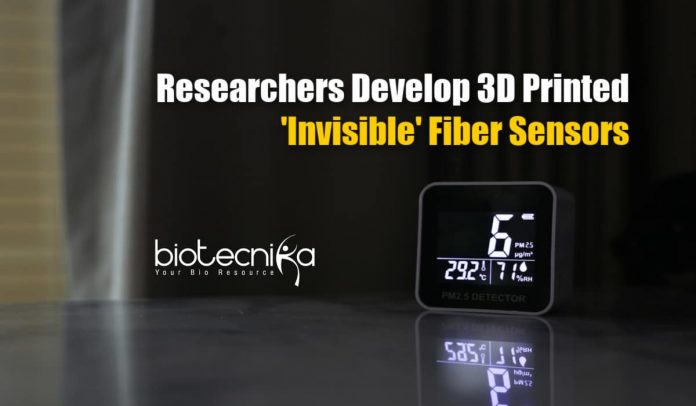3D Printed ‘Invisible’ Fibers Capable Of Sensing Sound, Breath & Biological Cells
University of Cambridge researchers have created sensors beyond the capabilities of conventional film-based devices using 3D printing, which is also called additive manufacturing, the method to make electronic fibers that are a hundred times thinner than a human hair.
According to the study reported in the journal Science Advances, portable, wearable, and non-contact respiratory sensors can be made by using the fiber printing technique. With features such as high-sensitivity, these low-cost printed sensors can be attached to a phone to collect breath pattern information, images, and sound simultaneously.
For respiratory conditions such as rapid breathing, normal breathing, simulated coughing, the amount of breath moisture leaked through face covering was tested using the fiber sensor by a Ph.D. student from Cambridge’s Department of Engineering, Andy Wang, the first author of the study.
Measuring the direction and amount of breath moisture that leaks through different kinds of face coverings using the sensor could act an indicator in the protection ‘weak’ points given the increasing scientific evidence for viral particles like the Covid-19 virus can spread through respiratory droplets and aerosols, though the fiber sensor has not been designed to detect
viral particles.The majority leakage from N95 masks was found to come from the top and sides with tight fittings, particularly while coughing, whereas in the case of surgical or fabric masks, most leakages were found to come from the front. Nevertheless, both types of face masks aid in weakening the flow of exhaled breath when worn properly.
From Cambridge’s Department of Engineering, the lead researcher, Dr. Yan Yan Shery Huang said, “For volumetric sensing of fluid and gas in 3D, when compared to conventional thin-film techniques, the sensors developed from small conducting fibers are particularly more useful. However, to print and for incorporating them into devices and manufacturing them at scale has been challenging so far.”
Made from semiconducting and/or silver polymers, Huang and her colleagues 3D printed the composite fibers. Just like the common electrical wires’ structure, but of a few micrometers in diameter, a core-shell fiber structure is created by this fiber printing technique, with a thin protective polymer sheath wrapping a high-purity conducting fiber core.
The printing technique can additionally be utilized for making biocompatible fibers of a similar dimension to biological cells, through which cell movements can be guided and this dynamic process can be ‘felt’ as electrical signals. When the fibers are employed for connecting small electronic elements in 3D, it would look like the electronics are ‘afloat’ in mid-air because of the fibers being so tiny that they are invisible to the naked eye.
Huang said, “The general public would be able to take self-administered tests and get information about their environments using our fiber sensors, as they could potentially be made into home-test devices given that they are easy to use, small, lightweight, and cheap.”
Huang and her research team look forward to developing this fiber printing technique for various multi-functional sensors, which could be potentially used for more applications.
Source
3D Printed ‘Invisible’ Fibers Capable Of Sensing Sound, Breath & Cells






























